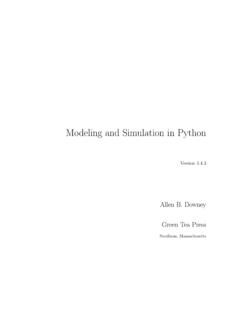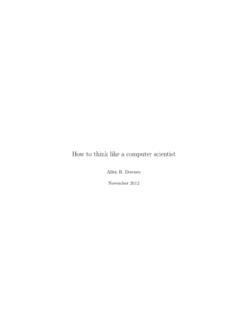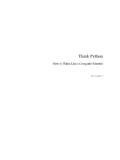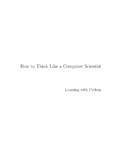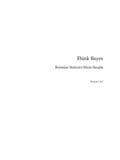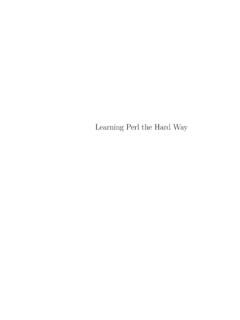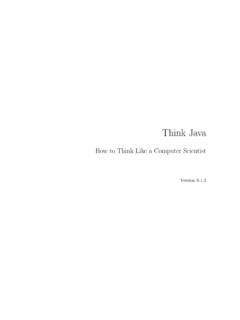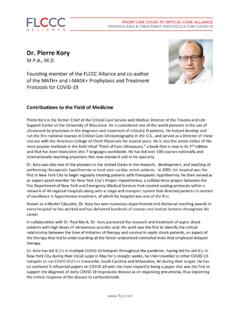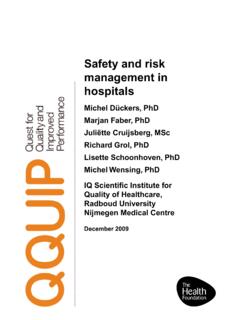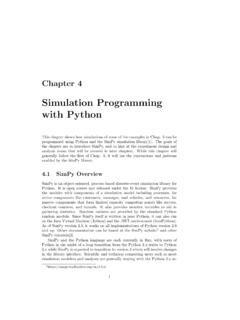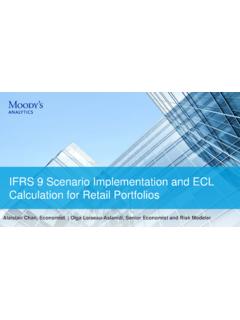Transcription of Think Stats - Green Tea Press
1 Think StatsExploratory Data analysis in PythonVersion StatsExploratory Data analysis in PythonVersion B. DowneyGreen Tea PressNeedham, MassachusettsCopyrightc 2014 Allen B. Tea Press9 Washburn AveNeedham MA 02492 Permission is granted to copy, distribute, and/or modify this document underthe terms of the Creative Commons International License, which is available LATEX source for this book is available Statsis an introduction to the practical tools of exploratory dataanalysis. The organization of the book follows the process I use when I startworking with a dataset: Importing and cleaning: Whatever format the data is in, it usuallytakes some time and effort to read the data, clean and transform it, andcheck that everything made it through the translation process intact.
2 Single variable explorations: I usually start by examining one variableat a time, finding out what the variables mean, looking at distributionsof the values, and choosing appropriate summary statistics. Pair-wise explorations: To identify possible relationships between vari-ables, I look at tables and scatter plots, and compute correlations andlinear fits. Multivariate analysis : If there are apparent relationships between vari-ables, I use multiple regression to add control variables and investigatemore complex relationships. Estimation and hypothesis testing: When reporting statistical results,it is important to answer three questions: How big is the effect? Howmuch variability should we expect if we run the same measurementagain?
3 Is it possible that the apparent effect is due to chance? Visualization: During exploration, visualization is an important toolfor finding possible relationships and effects. Then if an apparent effectholds up to scrutiny, visualization is an effective way to 0. PrefaceThis book takes a computational approach, which has several advantagesover mathematical approaches: I present most ideas using Python code, rather than mathematicalnotation. In general, Python code is more readable; also, because it isexecutable, readers can download it, run it, and modify it. Each chapter includes exercises readers can do to develop and solidifytheir learning. When you write programs, you express your under-standing in code; while you are debugging the program, you are alsocorrecting your understanding.
4 Some exercises involve experiments to test statistical behavior. Forexample, you can explore the Central Limit Theorem (CLT) by gener-ating random samples and computing their sums. The resulting visu-alizations demonstrate why the CLT works and when it doesn t. Some ideas that are hard to grasp mathematically are easy to under-stand by simulation. For example, we approximate p-values by runningrandom simulations, which reinforces the meaning of the p-value. Because the book is based on a general-purpose programming language(Python), readers can import data from almost any source. They arenot limited to datasets that have been cleaned and formatted for aparticular statistics wrote this book assuming that the reader is familiar with core Python,including object-oriented features, but not pandas, NumPy, and assume that the reader knows basic mathematics, including logarithms, forexample, and summations.
5 I refer to calculus concepts in a few places, butyou don t have to do any you have never studied statistics, I Think this book is a good place to if you have taken a traditional statistics class, I hope this book will helprepair the demonstrate my approach to statistical analysis , the book presents a casestudy that runs through all of the chapters. It uses data from two How I wrote this bookvii The National Survey of Family Growth (NSFG), conducted by Centers for Disease Control and Prevention (CDC) to gather information on family life, marriage and divorce, pregnancy, infer-tility, use of contraception, and men s and women s health. ( ) The Behavioral Risk Factor Surveillance System (BRFSS), conductedby the National Center for Chronic Disease Prevention and HealthPromotion to track health conditions and risk behaviors in the UnitedStates.
6 ( )Other examples use data from the IRS, the Census, and the second edition ofThink Statsincludes the chapters from the first edition,many of them substantially revised, and new chapters on regression, timeseries analysis , survival analysis , and analytic methods. The previous editiondid not use pandas, SciPy, or StatsModels, so all of that material is How I wrote this bookWhen people write a new textbook, they usually start by reading a stack ofold textbooks. As a result, most books contain the same material in prettymuch the same did not do that. In fact, I used almost no printed material while I waswriting this book, for several reasons: My goal was to explore a new approach to this material, so I didn twant much exposure to existing approaches.
7 Since I am making this book available under a free license, I wanted tomake sure that no part of it was encumbered by copyright restrictions. Many readers of my books don t have access to libraries of printed ma-terial, so I tried to make references to resources that are freely availableon the 0. Preface Some proponents of old media Think that the exclusive use of electronicresources is lazy and unreliable. They might be right about the firstpart, but I Think they are wrong about the second, so I wanted to testmy resource I used more than any other is Wikipedia. In general, the arti-cles I read on statistical topics were very good (although I made a few smallchanges along the way). I include references to Wikipedia pages through-out the book and I encourage you to follow those links; in many cases, theWikipedia page picks up where my description leaves off.
8 The vocabularyand notation in this book are generally consistent with Wikipedia, unlessI had a good reason to deviate. Other resources I found useful were Wol-fram MathWorld and the Reddit statistics forum, Using the codeThe code and data used in this book are available easiest way to work with this code it to run it on Colab, which is a freeservice that runs Jupyter notebooks in a web browser. For every chapter,I provide two notebooks: one contains the code from the chapter and theexercises; the other also contains the you want to run these notebooks on your own computer, youcan downloads them individually from GitHub or download the en-tire repository developed this book using Anaconda from Continuum Analytics, which is afree Python distribution that includes all the packages you ll need to run thecode (and lots more).
9 I found Anaconda easy to install. By default it does auser-level installation, so you don t need administrative privileges. You candownload Anaconda you don t want to use Anaconda, you will need the following Using the codeix pandas for representing and analyzing data, ; NumPy for basic numerical computation, ; SciPy for scientific computation including statistics, ; StatsModels for regression and other statistical analysis , ; and matplotlib for visualization, these are commonly used packages, they are not included with allPython installations, and they can be hard to install in some you have trouble installing them, I strongly recommend using Anacondaor one of the other Python distributions that include these packages.
10 Allen B. Downey is a Professor of Computer Science at the Franklin W. OlinCollege of Engineering in Needham, ListIf you have a suggestion or correction,please send email If I make a change based on your feedback, Iwill add you to the contributor list (unless you ask to be omitted).If you include at least part of the sentence the error appears in, that makesit easy for me to search. Page and section numbers are fine, too, but notquite as easy to work with. Thanks! Lisa Downey and June Downey read an early draft and made many correc-tions and suggestions. Steven Zhang found several errors. Andy Pethan and Molly Farison helped debug some of the solutions, andMolly spotted several 0.
